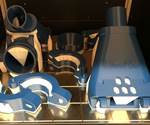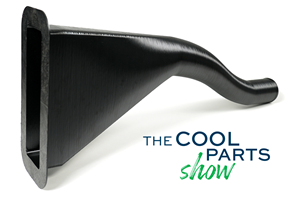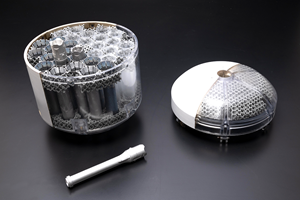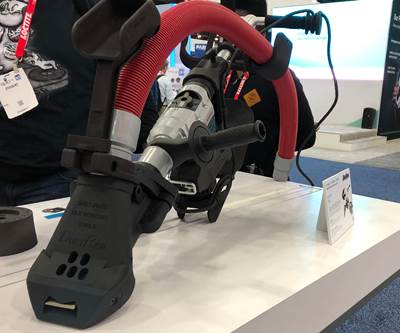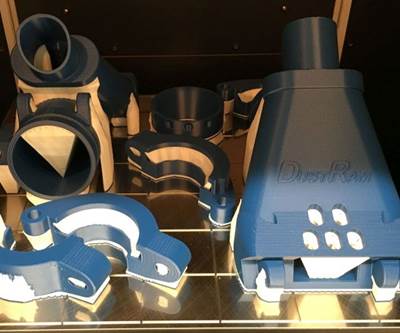3D Printed Plastic Replaces Metal: The Cool Parts Show #3
This small business owner discovered 3D printing as a way to manufacture his invention. Now, AM is enabling a totally new source of revenue. Watch The Cool Parts Show to see how.
Jack King initially turned to polymer 3D printing as a way to manufacture a lighter, cheaper version of his invention — the DustRam, a device used in flooring demolition. But after a 3D printed prototype stood up to weeks of use in the field, he began to manufacture the end-use parts this way. King now additively manufactures a complete range of professional products for flooring demolition using Multi Jet Fusion (MJF) from HP. He shares how 3D printed plastic replaced machine metal and more in this episode of The Cool Parts Show.
The Cool Parts Show is a video series from Additive Manufacturing Media that explores the what, how and why of unusual 3D printed parts. Watch more here.
Have a cool part to share? Email us.
Transcript
Stephanie Hendrixson, Additive Manufacturing
In this episode we're talking about a case where 3D printed plastic replaced machined metal Welcome to The Cool Parts Show
Peter Zelinski, Additive Manufacturing
I'm Pete Zelinski.
Stephanie Hendrixson
I'm Stephanie Hendrixson. We're with Additive Manufacturing Media and this is The Cool Parts Show.
Pete Zelinski
This is our show all about cool parts being made through 3D printing. So Stephanie, last time we did an episode you had these tiny little intricate metal implants. You have something like that again?
Stephanie Hendrixson
Not quite. So what I have today is much larger. There's actually two different products here, but the one that I really want to talk about is this bottom part. It's called the DustRam. This was invented by a guy named Jack King, the owner of Arizona Home Floors. It's a flooring demolition company, and the DustRam would fit around a chipping hammer. So the chisel part would come out of the nose at the bottom and then it connects to an industrial vacuum. And so as you're chipping up your tile or whatever kind of flooring you're dealing with, the DustRam is just instantly sucking in whatever dust is generated.
That means you don't have to cover things in plastic. Operators don't even need to wear dust masks. It just makes the whole process much easier, cleaner, faster. These products are part of a larger system that he's developed for professionals, and many of the parts are 3D printed including just about everything that you see here.
Pete Zelinski
So I can see the 3D printed parts, these dark forms. Was it always made this way?
Stephanie Hendrixson
No! Actually in the case of the DustRam, this originally used to be metal. It was mostly aluminum and then this nose down here at the bottom, the part that's actually hitting the floor and getting the most wear and tear, would have been made out of tool steel. These were all machined components that had to be welded and assembled together. He had to outsource all the production and so it could take like four months to get one of these made. Here's Jack King to talk a little bit about the challenges he was facing.
Jack King, DustRam / Arizona Home Floors
Well you know before I really became aware of 3D printing technology, pretty much everything I had built was built out of aluminum or steel with CNC manufacturing. While it worked pretty well, the parts were pretty expensive. Some of them were very heavy.
And then we ran into a roadblock when we were developing our vacuum. We really couldn't move forward unless we figured out a cost effective way to build certain parts of a vacuum because not everything could be built out of aluminum and expensive CNC parts. So when it comes to CNC, I mean that's just one component. Once you get done with that, now some of those parts are going to have to be welded. Now you're going to have to be really good at TIG welding. So that's a whole other component.
And so by 3D printing, the part can be pretty much printed all in one piece, which takes away welding and bolting on and screwing and all the other things that would go on if you were dealing with a metal part or metal parts that had to be assembled. I wouldn't have the time or the equipment or the room or anything like that to do the traditional CNC, welding and that kind of method.
Stephanie Hendrixson
So this is a company that really had a need for 3D printed plastic parts — for lightweighting, to deal with the complexity of the things they were trying to make. In the case of the DustRam, there was the added issue of cost. So Jack had this idea that if he could produce a cheaper plastic version of the product, that would give people a chance to try it out before they invested in the metal version. And so 3D printing comes along and it becomes a way of doing that.
He's now 3D printing using HP's Multi Jet Fusion process out of PA12 nylon, and what he's found is that actually this material in the 3D printed version is so durable that he only rarely sells the metal version anymore. So if you look at the front here, this nose down here is replaceable, because again it's still the part that's going to get the most wear and tear. But the last time we spoke he was telling me that there are 3D printed DustRams out in the field with their original noses that have been in use for more than a year now. So it's proven to be really really durable. One of the reasons that I brought this and wanted to talk about it is because it's such a good example of a 3D printed plastic part replacing something made of metal.
Pete Zelinski
So it's a it is a product improvement that he made, but there's a process improvement too, right? Because he's he's thinking about manufacturing in an altogether different way. So replaced metal with a durable plastic—the way that you would do that traditionally is with injection molding which for him would require a mini factory, right? He would need mold tooling. He would need an injection molding press.
Ditto when this was made of machined metal components — for him to produce this himself, he would need machine tools. He would need people doing assembly, which is why he outsourced it and which is why he had this big lead time to get his product made. But now with 3D printing, manufacturing is so much simpler that he's doing his own manufacturing right? The inventor is now the one producing the product.
Stephanie Hendrixson
Right, exactly. And so you bring up a couple of good points. Assembly, first of all. When the DustRam was made out of metal, this used to be 16 different metal parts. So all of those had to be machined and then welded and pinned together.
And then the idea of this mini factory — instead of having those machine tools or those injection molding presses, what he has is just one HP Multi Jet Fusion printer, one postprocessing unit, and then two build units. And Jack is running all of that equipment himself. He has some help with assembly and postprocessing, but essentially just one person can handle production.
Pete Zelinski
So it's not just that the company is doing its own manufacturing, it's the guy himself who invented it is doing the manufacturing.
Stephanie Hendrixson
The other really cool thing about this is that Jack still owns and runs Arizona Home Floors. Not only is he the developer of these products, the manufacturer of these products, he's still the user. And so it's much easier for him to make design changes, prototype and iterate designs, because he can just print a new version of something, hand it to somebody, have it out in the field later that day and get feedback really really quickly. He ends up developing better products because he's able to do all of this himself.
Pete Zelinski
Alright, that is cool. I agree this qualifies as our largest cool part so far.
Let me try to talk this out. The DustRam used to be made out of metal, machined metal components assembled together, 16 components. Now it's made by 3D printing. 3D printing allowed a way for a rugged plastic to take the place of a metal without any mold tooling needed. Where once there were 16 pieces now there are four different pieces because of the way 3D printing lets you just make more complex parts.
It's a better product as a result. It's lighter weight. It's easier for the customer to use, but it's easier to manufacture also. And where the inventor used to be turning to an outside manufacturer to get his product made, now the inventor is the manufacturer. He's got the 3D printer right inside his facility. The actual inventor is the one running the machines making the part and also right there tweaking the part continually to refine it because he's also its user.
Stephanie Hendrixson
So you might not know just from looking at it,but this is a really rugged, durable, professional-grade product made with 3D printing and what it represents for a small business like Jack’s is pretty significant.
That's it for this episode of The Cool Parts Show! If you have a cool 3D printed part you'd like to see featured, email us: coolparts@additivemanufacturing.media.
Thanks for watching. Don't forget to subscribe!
Related Content
Aircraft Ducts 3D Printed in Composite Instead of Metal: The Cool Parts Show #68
Eaton’s new reinforced PEKK, tailored to aircraft applications, provides a cheaper and faster way to make ducts compared to formed aluminum.
Read MoreHow 3D Printing Aids Sustainability for Semiconductor Equipment: The Cool Parts Show Bonus
Hittech worked with its customer to replace fully machined semiconductor trays with trays made via DED by Norsk Titanium. The result is dramatic savings in tool consumption and material waste.
Read More3D Printed Titanium Replaces Aluminum for Unmanned Aircraft Wing Splice: The Cool Parts Show #72
Rapid Plasma Deposition produces the near-net-shape preform for a newly designed wing splice for remotely piloted aircraft from General Atomics. The Cool Parts Show visits Norsk Titanium, where this part is made.
Read More3D Printed Lattice for Mars Sample Return Crash Landing: The Cool Parts Show Bonus
NASA Jet Propulsion Laboratory employs laser powder bed fusion additive manufacturing plus chemical etching to create strong, lightweight lattice structures optimized to protect rock samples from Mars during their violent arrival on earth.
Read MoreRead Next
Additive Manufacturing Media Announces New Web Series, The Cool Parts Show
Additive Manufacturing Media Announces New Web Series, The Cool Parts Show Series will focus on unique applications of 3D printing for manufacturing
Read More3D Printing Clears Path to Production for DustRam
DustRam did not start out as a manufacturer. But thanks to 3D printing, the company now makes many of its own products in house, in addition to parts for customers.
Read More3D-Printed Device Proves Rugged Enough for Dust-Free Tile Removal
Arizona Home Floors considered buying a mold to produce a plastic version of its DustRam product. But when a prototype proved durable enough to withstand working conditions, the production strategy shifted to 3D printing.
Read More
.jpg;width=70;height=70;mode=crop)


